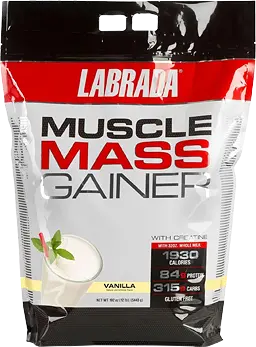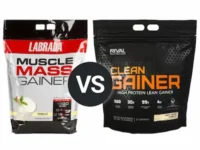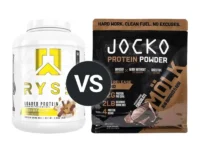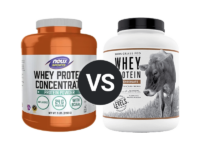Knowledge BaseYou're Questions Answered
Which protein powder has the most protein?
Firstly, if you're looking for a specific protein powder product with the highest percentage of protein content, then you should take a look at our Protein Reviews and sort the results by "Highest Protein" content. This will sort our reviews and provide them based on the protein content of each product.
Generally, however, when evaluating protein powders based on their protein content, it is important to consider both the form and source of the protein. Protein powders come in various forms, including concentrates, isolates, and hydrolysates, each with differing protein concentrations and characteristics. Additionally, the source of the protein, whether animal-based or plant-based, impacts its digestibility and amino acid profile.
Protein Forms
- Protein Concentrates: Protein concentrates typically contain around 70-80% protein by weight, with the remaining 20-30% comprised of fats and carbohydrates. This form of protein undergoes less processing compared to isolates and hydrolysates, preserving more of the natural nutrients found in the source1. Whey protein concentrate is a common example and is known for its balanced nutrient profile.
- Protein Isolates: Protein isolates undergo additional processing to remove most of the fats and carbohydrates, resulting in a higher protein content of around 90-95% by weight2. Whey protein isolate and soy protein isolate are popular examples. These isolates provide a more concentrated source of protein, making them suitable for those looking to maximize protein intake while minimizing additional calories from fats and carbs.
- Protein Hydrolysates: Protein hydrolysates are pre-digested proteins that have been broken down into smaller peptides through a process called hydrolysis. This makes them the fastest-digesting protein form, with a protein content similar to isolates, typically around 90-95% by weight3. Hydrolyzed whey protein is commonly used for its rapid absorption, making it ideal for post-workout recovery.
Protein Sources
- Whey Protein: Derived from milk, whey protein is a complete protein source that includes all essential amino acids. It is highly digestible and available in concentrate, isolate, and hydrolysate forms4. Whey protein isolate, for instance, contains approximately 90-95% protein and is rapidly absorbed, making it a top choice for muscle recovery and growth5.
- Casein Protein: Also derived from milk, casein protein is a slow-digesting protein that provides a steady release of amino acids over time. Casein protein isolate contains around 85-90% protein by weight6. It is particularly beneficial for sustaining protein synthesis throughout the night when taken before bedtime.
- Soy Protein: Soy protein isolate is a plant-based protein that contains about 90% protein by weight. It is a complete protein, providing all essential amino acids, and is suitable for vegetarians and vegans7. Soy protein is also known for its additional health benefits, such as supporting heart health8.
- Pea Protein: Derived from yellow peas, pea protein isolate contains around 80-85% protein by weight. It is a good option for those with dairy or soy allergies and provides a balanced amino acid profile, though it is slightly lower in certain essential amino acids compared to whey and soy9.
- Beef Protein: Hydrolyzed beef protein isolate is another high-protein option, typically containing 90-95% protein by weight. It is free from common allergens such as dairy and soy and provides a different amino acid profile, including naturally occurring creatine10.
Digestibility and Amino Acid Profile
The digestibility and amino acid profile of a protein source are crucial for its effectiveness in supporting muscle growth and recovery. Animal-based proteins, such as whey, casein, and beef, generally have higher digestibility and a more complete amino acid profile compared to most plant-based proteins. However, plant-based proteins like soy and pea protein can still provide adequate amino acids, especially when combined with other protein sources to ensure a complete amino acid intake11.
Choosing the right protein powder involves considering the protein content, digestibility, amino acid profile, and any dietary restrictions or preferences you may have. Consulting with a healthcare provider or nutritionist can help tailor protein supplementation to your specific needs and goals.
- Phillips, S. M., & Van Loon, L. J. C. (2011). Dietary protein for athletes: From requirements to optimum adaptation. Journal of Sports Sciences, 29(sup1), S29-S38.
- Hoffman, J. R., & Falvo, M. J. (2004). Protein–which is best? Journal of Sports Science & Medicine, 3(3), 118.
- Jäger, R., Kerksick, C. M., Campbell, B. I., Cribb, P. J., Wells, S. D., Skwiat, T. M., ... & Antonio, J. (2017). International Society of Sports Nutrition Position Stand: Protein and exercise. Journal of the International Society of Sports Nutrition, 14(1), 20.
- Boirie, Y., Dangin, M., Gachon, P., Vasson, M. P., Maubois, J. L., & Beaufrère, B. (1997). Slow and fast dietary proteins differently modulate postprandial protein accretion. Proceedings of the National Academy of Sciences, 94(26), 14930-14935.
- Rutherford, S. M., & Sathe, S. K. (2002). Food protein functionality in a complex system: A report on soy proteins in meat and poultry products. Journal of Food Science, 67(6), 2623-2627.
- Anderson, J. W., Johnstone, B. M., & Cook-Newell, M. E. (1995). Meta-analysis of the effects of soy protein intake on serum lipids. New England Journal of Medicine, 333(5), 276-282.
- Gorissen, S. H., & Witard, O. C. (2018). Characterising the muscle anabolic potential of dairy, meat and plant-based protein sources in older adults. Proceedings of the Nutrition Society, 77(1), 20-31.
- Jäger, R., Kerksick, C. M., Campbell, B. I., Cribb, P. J., Wells, S. D., Skwiat, T. M., ... & Antonio, J. (2017). International Society of Sports Nutrition Position Stand: Protein and exercise. Journal of the International Society of Sports Nutrition, 14(1), 20.
- Hoffman, J. R., & Falvo, M. J. (2004). Protein–which is best? Journal of Sports Science & Medicine, 3(3), 118.
- Boirie, Y., Dangin, M., Gachon, P., Vasson, M. P., Maubois, J. L., & Beaufrère, B. (1997). Slow and fast dietary proteins differently modulate postprandial protein accretion. Proceedings of the National Academy of Sciences, 94(26), 14930-14935.
- Rutherford, S. M., & Sathe, S. K. (2002). Food protein functionality in a complex system: A report on soy proteins in meat and poultry products. Journal of Food Science, 67(6), 2623-2627.

Your Answer
We are a participant in the Amazon Services LLC Associates Program, an affiliate advertising program designed to provide a means for us to earn fees by linking to Amazon.com and affiliated sites.


